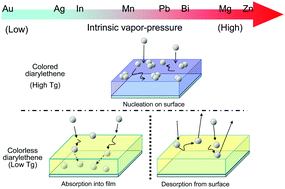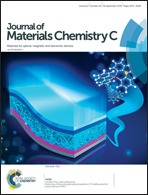Nucleation, absorption, or desorption of metal-vapor atoms on amorphous photochromic diarylethene films having a low glass transition temperature†
Abstract
A photochromic diarylethene surface shows selective metal-vapor deposition, in which metal-vapor atoms deposit on a colored surface having a high glass-transition temperature (high Tg) but not on a colorless surface with a low Tg. The core phenomenon of selective deposition is metal atom desorption from the soft colorless surface. Such a metal-atom desorption/deposition phenomenon exhibits metal-species dependence, and the origin of the dependence remains unelucidated. We found that metal-vapor deposition or desorption was correlated with the intrinsic vapor-pressure of metal species. Metals can be classified into three categories. (1) Metal atoms with low vapor-pressure tended to be absorbed into the colorless film. (2) Metal atoms with high vapor-pressure and low chemical reactivity enabled selective deposition, in which the metal atoms were easy to desorb from the colorless surface. A high substrate temperature (Tsub) and/or a low deposition rate (low Rd) enhanced such desorption or absorption, whereas a low Tsub and/or a high Rd accelerated the surface nucleation of the metals for film-formation on the colorless film. On the other hand, (3) metal atoms with high vapor-pressure and high chemical reactivity were deposited on the colorless surface; this was caused by a chemical reaction with surface molecules. These findings will be useful in applying selective metal-vapor deposition to metal-pattern formation in the field of electronics and photonics.



 Please wait while we load your content...
Please wait while we load your content...